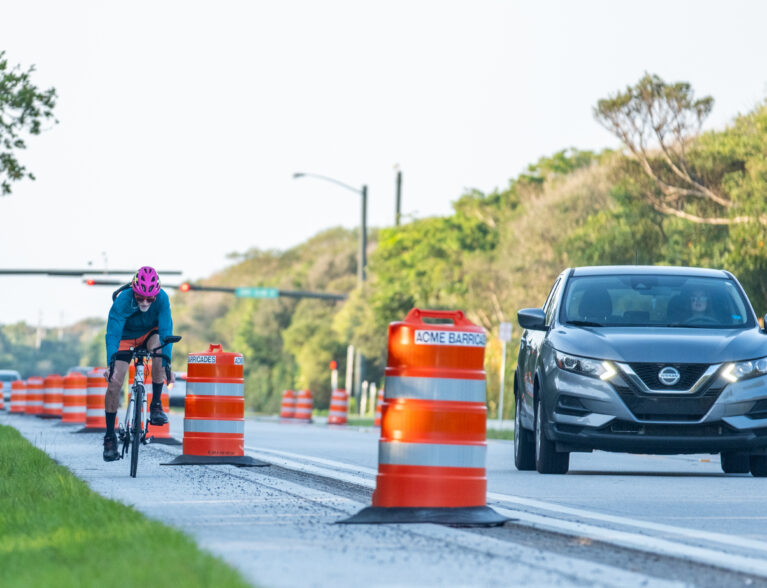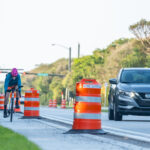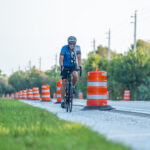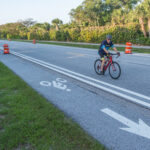
It seems like yesterday that State Road A1A, the island’s main thoroughfare, was mired in a construction project that seemed to last forever as the Florida Department of Transportation slightly widened and repaved the road, adding marked bicycle lanes on both sides.
Now, a few years after that project, the orange barrels have gone back up on a stretch of the road from the main entrance to John’s Island north to Sea Oaks, almost all the way to the Wabasso Causeway.
First the barrels appeared on the ocean side of the road, and last weekend, construction crews did the same on the west side as well.
The Florida Department of Transportation, it turns out, is removing the rumble strips it installed back then on the border between the automotive lanes and the exclusive bike lanes on both sides of the highway.
Those rumble strips were once hailed as a great safety enhancement because driving on them would create vibrations and unusual noises that would warn motorists they were drifting into the bicycle lanes.
Motorists would then presumably be jarred into correcting course and getting back in their lanes, avoiding potential collisions with cyclists.
However, most all local cyclists now say they hate the rumble strips and that instead of making the roads safer for them, they actually pose a bigger danger.
So the orange Acme Barricades barrels started going up again along A1A last week and FDOT told the Public Safety Department of the town of Indian River Shores that the project would last three weeks. All work was supposed to have been finished this coming Friday.
“But for a while, I didn’t actually see anyone working on it,” Assistant Indian River Shores Public Safety Chief Ed Ryer said at the end of last week, “so I don’t know if they’ll make that deadline.
We’re kind of at the mercy of FDOT here. A1A is a state road so they’re in charge.”
Ryer said he was advised by FDOT that a contractor was milling out the rumble strips and replacing them with normal pavement, and Ryer sent an internal email to his officers relaying the information.
“I’m actually glad they’re doing it,” Ryer said. “I know the cyclists hate them and I’ve never liked those rumble strips much myself. I just wish they’d get it done and over with.”
In the meantime, with bike lanes on both sides of the road virtually unusable and blocked off by orange barrels, all cyclists in both directions are forced to either use the pedestrian sidewalk on the west side of A1A, or try and slalom around the orange barrels in the narrow strip that was left of the bike lanes.
FDOT told the town that the rumble strips installed in the original A1A reconstruction project had “encroached on the bike path,” making this new corrective construction necessary.
“The original installation of those rumble strips was a huge mistake,” said Mark Shea, an island resident who says he rides his bike almost 50 miles a day along A1A in both directions. “Those strips rattle my teeth every day. This was probably well intended but not very well thought through. They certainly could not have asked any cyclists. These strips were not an improvement for the cycling community – just the opposite.”
Shea explained that the rumble strips effectively removed a portion of the lane for cyclists, and the strips were so “aggressive” that they could not only cause equipment damage with flat tires and bent bicycle rims, but also actually cause a rider to fall off his bicycle into the motor vehicle traffic lane.
He added that the strips were badly designed anyway and that by the time a motorist heard or felt the warning, he or she would already be in the bike lane and in serious danger of causing a collision with a cyclist.
“Several weeks ago, an older gentleman came into contact with the rumble strips at A1A and Winter Beach Road,” Shea recalled. “It knocked him off his bike and beat him and his bike up very badly.”
FDOT communications specialists asked for questions about the rumble strip project to be submitted in writing but did not respond by the deadline for this edition.
Cyclists had earlier won another battle with FDOT over rumble strips at a recent public meeting to discuss plans for an additional sidewalk on the ocean side of A1A from the 17th Street Bridge Causeway south to the St. Lucie County line. That project had originally also included repaving the main roadway and installing bike lanes on both sides with rumble strips.
But after hearing several members of the Bike Walk of Indian River County organization outline the dangers of rumble strips to cyclists, the FDOT engineers chairing the meeting announced – to loud cheers from the audience – that any final proposal for that project would no longer include rumble strips for bike lanes.
However, on its website, FDOT continues to hail the installation of rumble strips as a great safety improvement.
At a cost of $1.6 million, FDOT says it is still busy installing rumble strips along 11 different roadway corridors in Martin, St. Lucie and Indian River counties. The contactor, TRP Construction Group, LLC, was supposed to have completed all those jobs by the spring of this year.
The rumble strips are ground into the roadway and provide auditory and vibratory feedback when driven over and alert drivers when they drift outside of travel lanes.
“Rumble strips are one of the most effective safety countermeasures to reduce run-off-the-road and head-on crashes,” the FDOT website proclaims.
Photos by Joshua Kodis







